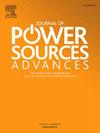Optimizing the thermal treatment procedure using electrochemical methods to improve the performance of vanadium redox flow batteries
IF 4.6
Q2 CHEMISTRY, PHYSICAL
引用次数: 0
Abstract
In this article, different thermal treatment procedures were carefully investigated by electrochemical methods to find the optimized time and temperature for enhancing the electrochemical performance and activity of the graphite felt electrodes within the vanadium redox flow battery. Two prestigious and commercially used graphite felts of SGL GFD 4.65 EA and AvCarb G150 were used for this purpose. Cyclic voltammetry results initially were used to recognize the procedures with the most improved kinetics. This demonstrated the influences of treatment procedures on electrode kinetics by showing an improved electrode rate constant. In the following, area-specific resistance obtained by the polarization curves technique was used to examine the role of the thermal treatment procedure on improvement of the mass-transfer effect and, consequently, explore a treatment procedure to maximize the electrode activity. Both obtained CV and ASR data showed a better performance for thermally treated SGL 4.65 EA compared to that of AvCarb G150. Enhancing the electrode kinetics due to thermal treatment showed the largest contribution to reducing the ASR indicated by electrochemical impedance spectroscopy of the SGL 4.65 EA. The best electrode performance and activity was observed using the thermal treatment of the SGL 4.65 EA at 500/550 °C for 3/3.5 h with an ASR of 0.63/0.64 Ωcm2, respectively, lower than prior works with almost the same membrane properties. An interesting conclusion is that thermal treatment with an optimized procedure can sufficiently catalyze vanadium redox reactions on graphite felts better than those treated with electro-catalysts impressing no need for further electrode modification.

利用电化学方法优化热处理工艺,提高钒氧化还原液流电池的性能
本文采用电化学方法对不同的热处理工艺进行了仔细的研究,以找到提高钒氧化还原液流电池内石墨毡电极电化学性能和活性的最佳时间和温度。为此使用了两种著名的商用石墨毡:SGL GFD 4.65 EA和AvCarb G150。循环伏安法的结果最初被用来识别动力学改善最大的过程。这证明了处理程序对电极动力学的影响,通过显示一个改进的电极速率常数。下面,利用极化曲线技术获得的面积比电阻来检验热处理工艺对改善传质效果的作用,从而探索一种使电极活性最大化的处理工艺。获得的CV和ASR数据均显示,与AvCarb G150相比,经过热处理的SGL 4.65 EA具有更好的性能。电化学阻抗谱显示,热处理对电极动力学的增强对降低ASR的贡献最大。在500/550℃条件下,对SGL 4.65 EA进行3/3.5 h的热处理,ASR为0.63/0.64 Ωcm2,其电极性能和活性最好,低于几乎相同膜性能的先前工作。一个有趣的结论是,与电催化剂处理相比,优化后的热处理工艺可以充分催化石墨毡上的钒氧化还原反应,无需进一步的电极修饰。
本文章由计算机程序翻译,如有差异,请以英文原文为准。
求助全文
约1分钟内获得全文
求助全文

 求助内容:
求助内容: 应助结果提醒方式:
应助结果提醒方式:


